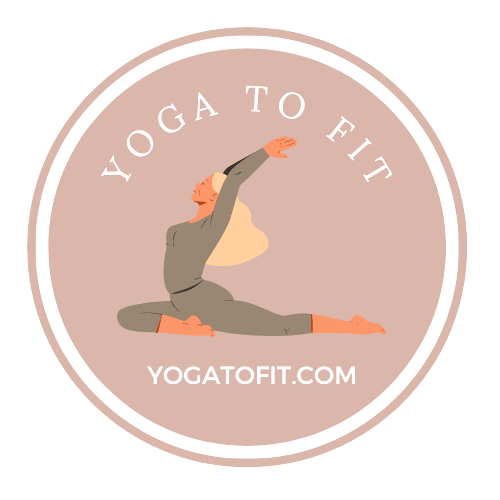How to do Aerial Yoga? 8 Easy Poses for Beginners
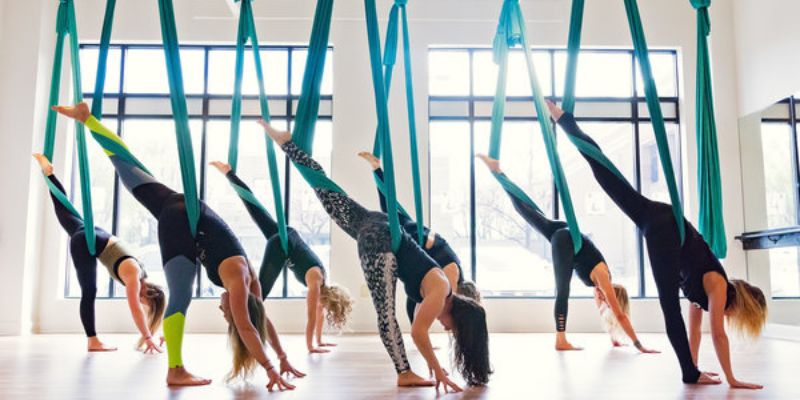
Aerial yoga also referred to as anti-gravity yoga is one of the most accessible and fun styles of modern yoga which enhances overall fitness and health of your body. Aerial Yoga deeply stretches your muscles and enhances the working of the spine, shoulders, and back. This article is about what all aerial yoga poses are, who can do aerial yoga, and how to practice them.
Can anyone do Aerial Yoga?
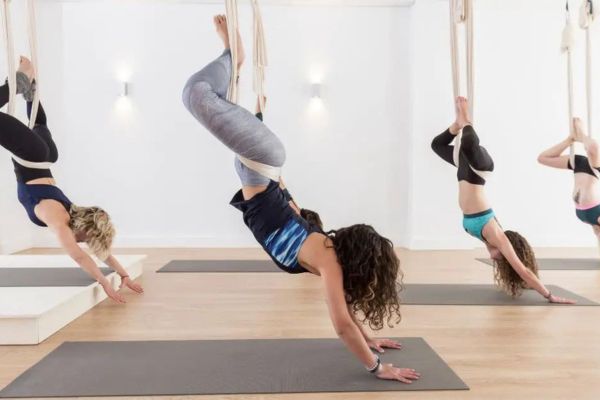
While aerial yoga can be enjoyed by many, it’s important to consider individual fitness levels and any physical limitations. Beginners should start with introductory classes led by certified instructors to learn proper techniques and safety measures.
Pregnant individuals, those with certain medical conditions, or recent surgeries should consult with a healthcare provider before attempting aerial yoga. With proper guidance and precautions, aerial yoga can be a rewarding practice for a wide range of people.
Types of Aerial Yoga Poses
1. Aerial Bridge Pose (Setubhanda Sarvangasana Aerial)
The Aerial Bridge Pose is great for relaxing and a good startup for a beginner’s aerial yoga flow.
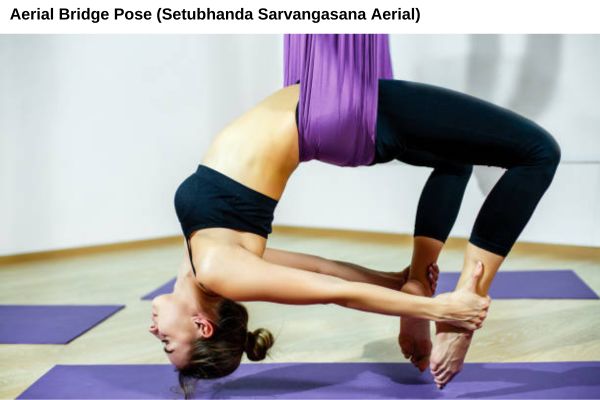
How to Practice:
- With your yoga swing set at the level of your knees (or higher), lie down on the ground.
- Insert your legs into the sling, letting the fabric support you from the ankles.
- Keep your arms lying flat on your sides as well.
- Lift your body up using your core — this is the important part.
- Remember to breathe. Do your chosen meditation and focus on what you are doing.
- Stay in this pose for at least 2 cycles of your breathing exercise or for one minute.
- This pose is great for strengthening the abdominal muscles.
2. Aerial One Leg Cat-Cow Pose (Bitilasana Marjaryasana One Leg Aerial)
Keep the height of your swing. Or, if you are uncomfortable, you can lower it down a little but make sure that your legs will be parallel to the ground upon insertion.
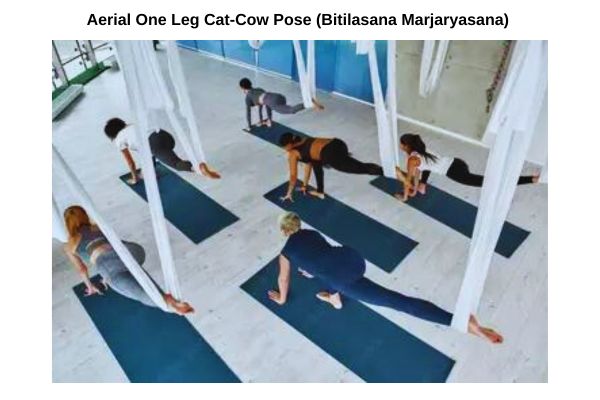
How to practice:
- Get on all fours and insert your left leg into the sling again letting the fabric support you at your ankles.
- Like the traditional cat-cow pose, inhale as you bend outwards and exhale as you bend inwards.
- In this pose, it is alright to skip the chanting or manifestations since it is important to focus solely on breathing and making sure you are executing the pose properly.
- As you go on, make sure that your body is coordinating well and stretching in the right places.
- Repeat this for at least 8-10 times on each leg.
3. Ankle Catch High Lunge Pose (Ankle Catch Anjaneyasana)
In this next pose, you can transition from the last pose by slowly standing up while keeping the leg inserted in the swing.
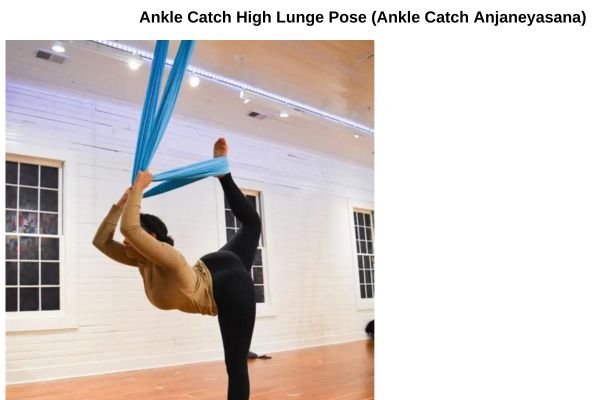
How to practice:
- Once you are standing, with your left leg inserted in the swing, step your right leg forward, assuming a lunging position.
- Then, raise your arms up above your head reaching to the sky.
- This pose is empowering and opens up your chest helping you breathe and think better.
- This is one of the poses where manifestations work best!
- Stay in this pose for at least 30 seconds before proceeding with the session.
- You can also do this by side. For example, do the Aerial One Leg Cat-Cow Pose with your right leg, then transition to the Ankle Catch High Lunge Pose.
- From then, do the same on the other side.
4. Aerial High Plank (Phalakasana Aerial)
The next pose is an aerial plank variation that helps strengthen your arms and core. This requires you to focus on keeping your body propped up and stable as much as you can. Do not worry if you shake while doing it. It is normal to shake in doing plank.
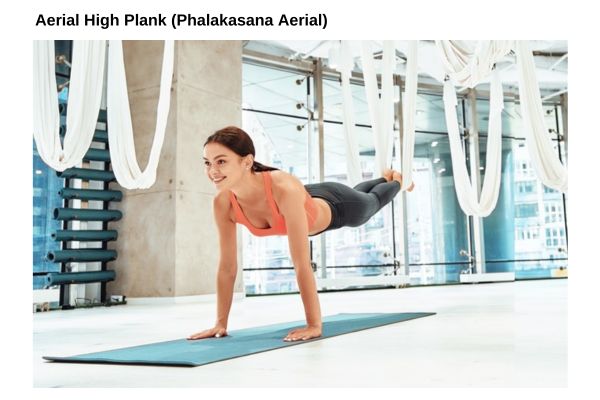
How to practice:
- Adjust your sling at a level that will have you parallel to the ground upon execution of this pose.
- Insert both of your legs into the swing and assume a high plank position.
- Make sure that your arms are aligned to your shoulder, not too far forward or too bent behind. Keep them nice and straight.
- Try to keep your back straight as well and remember to mostly use your core to hold yourself up.
- Breathe. Meditate. Remember your purpose.
- Stay in this pose for 30 seconds up to one minute.
5. Aerial Thigh Catch High Lunge Pose (Thigh Catch Anjaneyasana Aerial)
This pose will test your leg strength. If you find this too hard for you right now, then it is okay to skip this one out in the meantime.
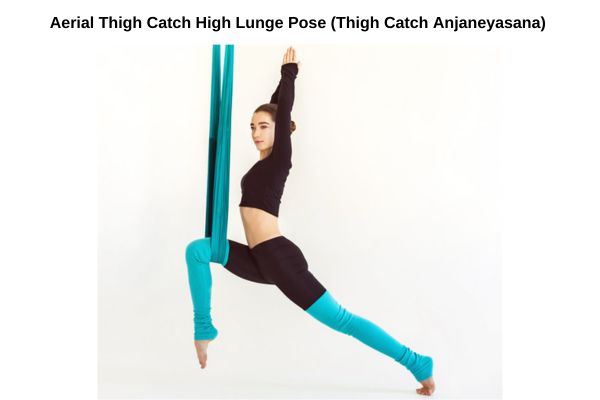
How to practice:
- Insert your left leg into your swing, letting the fabric wrap under the back of your thigh just about the back of your knees.
- Hold high onto the swing using both arms. Keep them straight.
- Then, bend forward letting your right leg extend backward. You should feel the stretch in your inner thighs and standing leg.
- Do not forget to do this on the other side.
- Do this pose for 30 seconds to one minute.
6. Aerial Upward Plank Pose (Purvottanasana Shoulders Aerial)
In this standing pose, adjust your sling higher, letting it be chest-level.

How to practice:
- Insert your upper body in it as well as your arms. Let the swing wrap your upper back and extend your arms sidewards with the palms in the supine position (forward).
- After making sure that you are properly mounted, slowly lean back and allow your swing to support you but do not slouch. Still, keep your body straight.
- Keep your feet flat on the ground as well.
- This pose is also very relaxing and works well with enunciating manifestations or even simple humming. Just do not forget to breathe, at least.
- Stay in this pose for one minute, or longer if you would like.
- To add some variation, put your palms together and raise them above your head, still aligned with your entire body. Bring your head with you as you stretch your arms.
7. Aerial Airplane Arms Plank Pose (Phalakasana Hasta Vimanasana Aerial)
From the last pose, just lean your body forward from previously leaning backward.
How to practice:
- The fabric must now be supporting you at your shoulders.
- Still, keep your feet flat on the ground and stretch your arms sidewards.
- This pose is freeing and also opens up the chest.
- Stay in this pose for at least 6 breaths before proceeding.
8. Aerial Chair Pose (Utkatasana Aerial)
In this pose, it’s alright if you would like to adjust your sling and lower it down a bit.
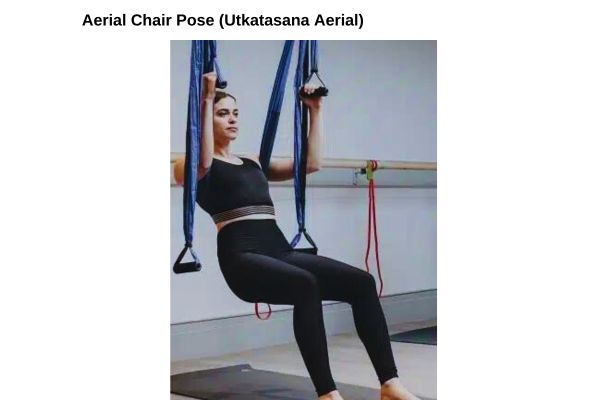
How to practice:
- From the last pose, stand back up and slowly sit down, as if sitting on an existing chair.
- Let the fabric support your back and raise your arms up parallel with your fabric.
- Remember to just keep breathing while performing the chair pose. Whenever you do this, know that you are helping oxygen get into your brain faster, helping you process things better.
Read More: Introducing Yoga to Kids in a School Classroom
Conclusion
Aerial Yoga is a modern yoga practice that caters to people of all ages, fostering emotional, spiritual, and physical well-being. Whether you’re a novice or a seasoned yogi, it’s accessible to everyone, adapting to all skill levels.
Following instructor guidelines and tuning into your body ensures a safe experience. With benefits ranging from improved cardiovascular health to increased flexibility and strength, Aerial Yoga offers a unique journey of self-awareness and holistic wellness.
FAQs
Can aerial yoga help with back pain?
Aerial yoga can provide relief for back pain by decompressing the spine and improving posture and core strength. However, it’s essential to consult with a healthcare professional before beginning any new exercise program, especially if you have a pre-existing condition.
Are there any age restrictions for practicing aerial yoga?
Age restrictions may vary by studio, but many welcome participants of various ages, as long as they can follow instructions and safely engage in the practice. Always check with the studio for their specific policies.
How can I find a reputable aerial yoga instructor or studio?
To find a reputable aerial yoga instructor or studio, you can search online, read reviews, ask for recommendations from friends or yoga practitioners, and ensure that the instructor is certified in aerial yoga instruction.
Can I do aerial yoga if I have a fear of heights?
Aerial yoga is performed at various heights, but most poses are done close to the ground. If you have a fear of heights, you can start with low-hanging poses and gradually work your way up as you become more comfortable.
